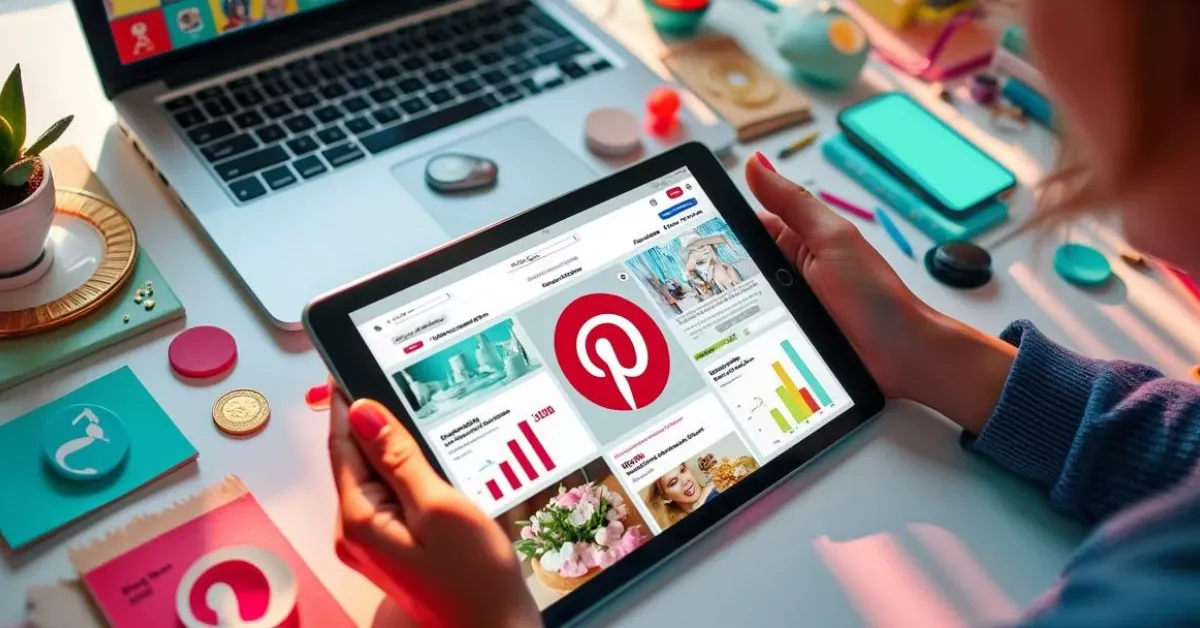Pinterest. For many, it’s a digital scrapbook, a place to find inspiration for home makeovers, dream holidays, or the perfect recipe. But for savvy bloggers and creators, it’s much more than that. It’s a dynamic visual search engine and a surprisingly potent platform for leveraging Pinterest for affiliate marketing.

If you’re looking to turn your creative content into a steady stream of income, understanding how to harness Pinterest for affiliate sales is a game-changer. This guide will walk you through specific strategies, from compelling pin design and smart board organisation to the nuts and bolts of Pinterest SEO, all designed to help you drive those affiliate commissions.
Whether you’re new to the platform or looking to refine your existing strategy, get ready to transform your Pinterest presence into an affiliate powerhouse.
Why Pinterest is a Goldmine for Affiliate Marketers
Before we get into the “how-to,” let’s look at why Pinterest deserves your attention for affiliate marketing. Unlike other social media platforms where content has a fleeting lifespan, Pinterest offers unique advantages.
Firstly, user intent on Pinterest is remarkably high. People actively use Pinterest to plan purchases and discover new products. According to Shopify, a staggering 80% of weekly Pinners use the platform with an intention to shop. They are not just passively scrolling; they are searching, saving, and, importantly, buying. This makes them a highly receptive audience for your affiliate recommendations.
Secondly, Pinterest is inherently visual. This makes it the perfect stage to showcase products in an attractive and engaging way. A well-crafted Pin can capture attention and drive clicks far more readily than a simple text link. The visual nature allows you to tell a story around a product, making it more desirable.
Another key benefit is the longevity of Pins. As noted by AffiliateMarketingForSuccess.com, Pins can continue to drive traffic and sales for months, or even years, after being published. This is a stark contrast to platforms where posts disappear from feeds within hours. This “evergreen” quality means your efforts can yield results long into the future.
The platform also boasts a massive and growing user base. AffiliateMarketingForSuccess.com highlights that Pinterest has over 553 million monthly active users, with significant year-over-year growth. In terms of demographics, while traditionally popular with women (around 70% of users), the platform is increasingly attracting male users and a significant Gen Z audience. Many Pinners also have a higher household income, indicating strong purchasing power, as mentioned in the Shopify guide. This combination of high intent, visual appeal, content longevity, and a large, engaged audience makes leveraging Pinterest for affiliate marketing an incredibly attractive prospect.
Getting Started: Setting Up for Pinterest Affiliate Success
To effectively tap into Pinterest affiliate marketing, you need to lay a solid foundation. This involves choosing the right niche and products, setting up your account correctly, and understanding the platform’s rules.

Choosing Your Niche and Products Wisely
Authenticity resonates with audiences. Focus on a niche you’re genuinely passionate and knowledgeable about. This will make your content more engaging and trustworthy. When selecting affiliate products, choose items that align with your niche and would genuinely benefit your audience. Quality is paramount; promote products you believe in and, if possible, have used yourself. Look for reputable affiliate programs. While Amazon Associates is a common starting point, platforms like ShareASale and Rakuten offer a wide variety of merchants and products, as suggested by Ahitechno.com. Consider commission rates, cookie duration, and merchant support when choosing programs.
Your Pinterest Business Account: The Foundation
If you’re serious about leveraging Pinterest for affiliate marketing, a Pinterest Business account is non-negotiable. It’s free to switch from a personal account or create a new one. A business account gives you access to crucial tools like Pinterest Analytics, advertising options, and Rich Pins, all of which are vital for tracking performance and optimising your strategy, as pointed out by Shopify.
Once set up, optimise your Pinterest profile.
- Username: Choose a username that is easily searchable and reflects your brand or niche.
- Profile Photo: Use a clear, high-quality photo of yourself or your brand logo.
- Bio: Craft a keyword-rich bio that clearly describes what you do and who you help. Think about the terms your ideal audience would search for. For example, instead of just “Lifestyle Blogger,” try “Your guide to budget-friendly home decor and DIY projects.”
Understanding Pinterest’s Rules for Affiliates
Pinterest has specific guidelines for affiliate marketers, and it’s important to follow them to maintain a good standing.
- Disclosure is Key: Transparency is vital. The Federal Trade Commission (FTC) requires you to disclose your affiliate relationships. This means clearly indicating that your Pin contains affiliate links (e.g., using #affiliate, #ad, or “affiliate link” in your Pin description). Many sources, including Shopify and Ahitechno.com, stress this.
- No Link Cloaking: Pinterest advises against using link shorteners or cloaking affiliate links. Users should be able to reasonably anticipate where a link will take them.
- Provide Value, Don’t Spam: Your primary focus should be on providing value to your audience. Pins that solely push products without context or benefit are unlikely to perform well and can be seen as spammy. Create content that inspires, educates, or solves a problem, naturally incorporating your affiliate links.
- Consequences: Ignoring these rules can lead to your Pins being demoted, your account being flagged, or even suspension. It’s always better to play by the rules.
Crafting “Power Pins”: Design and Content Strategies
The visual appeal of your Pins is paramount on Pinterest. A “Power Pin” is one that not only looks good but also effectively communicates value and encourages clicks. Here’s how to create them.
The Anatomy of a High-Converting Pin
- Visually Appealing Graphics: This is non-negotiable. Use high-quality, clear, and vibrant images or videos. Vertical images perform best, with an ideal aspect ratio of 2:3 (e.g., 1000 x 1500 pixels), as recommended by AffiliateMarketingForSuccess.com. Avoid blurry or poorly lit visuals.
- Text Overlays: Add clear, concise, and compelling text overlays to your images. This text should grab attention and highlight the Pin’s main benefit or topic. Use easy-to-read fonts and ensure good contrast between the text and the background. Think of it as a mini-headline for your Pin.
- Strong Call to Action (CTA): Tell people what you want them to do. Phrases like “Shop the look,” “Learn more,” “Get the recipe,” or “Click to discover” can significantly increase engagement.
- Branding: Maintain a consistent look and feel across your Pins. Use your brand colours, fonts, and logo (subtly) to build recognition.
Pin Formats to Explore
Pinterest offers various Pin formats, and experimenting with them can help you reach a broader audience and keep your content fresh.
- Standard Pins (Image Pins): These are the most common type, featuring a static image. They are great for showcasing products, blog post graphics, or inspirational imagery.
- Video Pins: Short, engaging videos can be very effective for demonstrating products in use, sharing quick tutorials, or telling a story. Shopify’s guide mentions their utility.
- Idea Pins: These are multi-page Pins that allow you to share step-by-step guides, collections of products, or more in-depth stories. Ahitechno.com notes that Pinterest now allows affiliate links on all Pin formats, including Idea Pins, which is a significant update.
- Rich Pins: These are a must for affiliate marketers. Rich Pins automatically sync information from your website to your Pins. There are different types:
- Product Pins: Show real-time pricing, availability, and where to buy the product.
- Article Pins: Display a headline, author, and story description.
- Recipe Pins: Include ingredients, cooking times, and serving sizes.
Enabling Rich Pins (you usually do this once by adding some metadata to your site and validating it with Pinterest) makes your Pins more informative and professional, as highlighted by both Shopify and Ahitechno.com.
Creating Multiple Pins for Single Content Pieces
Don’t just create one Pin for each blog post or affiliate product. Create several variations. As Shopify’s guide suggests, this strategy allows you to target different keywords, experiment with various designs and CTAs, and appeal to different segments of your audience. For example, for a blog post about “Summer Fashion Trends,” you could create Pins focusing on specific items like “Stylish Summer Dresses,” “Must-Have Sandals,” or “Beach Outfit Ideas,” all linking back to the same article. This increases your content’s visibility and reach.
Strategic Pinning: Organisation and SEO
Creating beautiful Pins is only half the battle; you also need to ensure they get seen by the right people. This is where strategic board organisation and Pinterest SEO come into play.

Mastering Pinterest SEO
Many people don’t realise that Pinterest functions much like a visual search engine. Users type keywords into the search bar to find ideas, products, and inspiration. Therefore, optimising your content for these searches is crucial for leveraging Pinterest for affiliate marketing.
- Keyword Research: Identify the terms your target audience is searching for. You can use:
- Pinterest’s own search bar: Start typing relevant terms and see what suggestions appear.
- Pinterest Trends: This tool shows you what’s popular on Pinterest in different regions.
- Google Keyword Planner: While for Google, it can give you broader keyword ideas.
- Pinterest Ads Keyword Tool: As suggested in the Shopify article, signing into Pinterest Ads can help you find keywords with good monthly volume.
- Where to Use Keywords:
- Pin Titles: Make your titles clear, descriptive, and keyword-rich.
- Pin Descriptions: Write detailed descriptions (up to 500 characters) that naturally incorporate relevant keywords. Explain what the Pin is about and what value it offers. Don’t just stuff keywords; write for humans first, search engines second.
- Board Titles & Descriptions: Use keywords here too, reflecting the board’s theme.
- Profile Bio: As mentioned earlier, include relevant keywords in your profile.
- Hashtags (Sparingly): While not as central as on some platforms, a few relevant hashtags can help with discoverability. Focus on specific, niche hashtags.
Organising Your Boards for Maximum Impact
Well-organised boards make it easier for users to find your content and understand what your profile is about.
- Create Niche-Specific Boards: Instead of broad categories, create more focused boards. For example, instead of “Food,” have “Quick Weeknight Dinners,” “Healthy Breakfast Ideas,” and “Vegan Desserts.”
- Optimise Board Titles and Descriptions: Use clear, keyword-rich titles for your boards. Write detailed descriptions for each board, explaining what kind of content users can expect to find there and incorporating relevant keywords.
- Pin Consistently: Regularly add new Pins to your boards. Ahitechno.com advises that consistency helps keep your content in your followers’ feeds and signals to Pinterest that your account is active.
- Board Covers: Choose visually appealing and consistent board covers to make your profile look professional and organised.
Leveraging Group Boards
Group boards, where multiple contributors can Pin content, were once a major strategy for reach. While their impact may have lessened somewhat, high-quality, niche-specific group boards can still offer some exposure to a new audience. The Shopify guide mentions them as a way to promote Pins to each other’s audiences. If you explore this, focus on boards with active engagement and clear contribution guidelines. Always prioritise creating your own high-quality boards first.
Driving Traffic and Sales: Advanced Tactics
With your Pins created and boards organised, it’s time to focus on tactics that directly drive traffic and convert that traffic into affiliate sales.
Linking Strategies: Direct vs. Indirect
There are two main ways to use affiliate links on Pinterest:
- Direct Linking: This involves linking your Pin directly to the affiliate product page. Some affiliate programs and Pinterest itself allow this, but always check the terms. It can be effective for Pins that clearly showcase a single product. However, ensure your Pin description still provides context and value.
- Indirect Linking (Content-First Approach): This is often the preferred and more sustainable strategy. Instead of linking directly to a product, you link your Pin to a piece of your own content (e.g., a blog post, a review, a tutorial, or a curated list) that features the affiliate product(s). This approach allows you to:
- Provide more value and build trust with your audience.
- Include multiple affiliate links within one piece of content.
- Control the user experience more effectively.
- Improve your website’s SEO.
This method aligns with Pinterest’s desire for valuable, informative content rather than just ads.
Building an Email List from Pinterest Traffic
One of the smartest moves you can make is to use your Pinterest traffic to build an email list. As Monica Lent, founder of Affilimate, points out in the Shopify article, Pinners are often in a planning phase, and their purchase might happen long after your affiliate cookie has expired. By capturing their email address (e.g., by offering a freebie like a checklist, guide, or discount related to your Pin’s topic), you can nurture them over time and promote affiliate products through email campaigns. This gives you a direct line of communication with an engaged audience.
Analysing Your Performance with Pinterest Analytics
Pinterest Analytics is your best friend for understanding what’s working and what’s not. Pay attention to key metrics such as:
- Impressions: How many times your Pins were shown.
- Engagements: Total interactions with your Pins (saves, clicks, outbound clicks).
- Outbound Clicks (or Link Clicks): How many times people clicked through to your website or affiliate link. This is a crucial metric for affiliate sales.
- Saves (formerly Repins): Indicates that users find your content valuable enough to save for later.
Regularly review your analytics (as suggested by Ahitechno.com) to identify your top-performing Pins and boards. What topics resonate most? Which Pin designs get the most clicks? Use these insights to refine your strategy and create more of what your audience loves.
Scheduling Pins for Consistency
Consistency is key on Pinterest. To maintain a regular pinning schedule without being tied to your device 24/7, consider using scheduling tools. Platforms like Tailwind, Later, or Hootsuite allow you to schedule Pins in advance, ensuring a steady flow of content. The Shopify guide mentions these tools as a way to save time and maximise reach by pinning when your audience is most active.
Leveraging Pinterest for affiliate marketing is not a get-rich-quick scheme. It requires a thoughtful strategy, consistent effort, and a genuine desire to provide value to your audience. By focusing on creating high-quality, visually appealing Pins, optimising your content for Pinterest SEO, organising your boards effectively, and analysing your performance, you can transform Pinterest into a significant source of affiliate income. Start implementing these strategies today, experiment to find what works best for your niche, and watch your affiliate sales grow.


